 Australian Capital Territory Numbered Regulations
Australian Capital Territory Numbered Regulations Australian Capital Territory Numbered Regulations
Australian Capital Territory Numbered Regulations
B-double
(a) to be attached to the rear of a motor vehicle (other than a motorbike or a motortrike); and
(b) to transport bicycles, wheelchairs, invalid chairs or, if approved by the road transport authority, other apparatus or vehicles.
Note Copies of British Standards are available from offices of Standards Australia.
(a) seats no more than 9 adults (including the driver); and
(b) has a body commonly known as a sedan, station wagon, coupe, convertible or roadster; and
(c) has 4 or more wheels.
(a) that is of the kind known as a utility, station wagon or panel van; and
(b) that is of the same make as a factory-produced car; and
(c) in which the part of the body form that is in front of the windscreen, and most of the mechanical equipment, are the same or substantially the same as in a factory-produced car.
(a) if the group consists of 2 axles, one of which is fitted with twice the number of tyres as the other axle¾a line located 1/3 of the way from the centre-line of the axle with more tyres towards the centre-line of the axle with fewer tyres; or
(b) in any other case¾a line located midway between the centre-lines of the outermost axles of the group.

Centre-line of a
tandem axle group fitted with an equal number of tyres on each
axle

Centre-line of a tandem
axle group fitted with different numbers of tyres on each
axle

Centre-line of a tri axle group

Centre-line of a quad axle group

Converter dolly
(a) if the vehicle has 1 headlight-dip the main beam of light projected by the headlight, or turn off the headlight and simultaneously turn on an alternative headlight; or
(b) if the vehicle has 2 headlights—dip the main beam of light projected by each headlight, or turn off the headlights and simultaneously turn on 2 alternative headlights; or
(c) if the vehicle has 4 headlights in sets of 2—turn off the high beam in each set.
(a) 1 axle group or single axle at the front that is steered by connection to the towing vehicle by a drawbar; and
(b) 1 axle group or single axle at the rear.

Dog
trailer
(a) the day it was last registered; or
(b) if it is unregistered and is to be registered—the date of registration.
(a) is built—
(i) as an excavator, road grader, road-roller, bulldozer, forklift truck or similar item of equipment; or
(ii) to perform a function that equipment mentioned in subparagraph (i) can perform; and
(b) is not built on a chassis of a type normally used in the construction of a truck.
(a) not higher than the centre of the headlight or fog light, when measured 8m in front of the vehicle; and
(b) not more than 1m higher than the level where the vehicle is standing, when measured 25m in front of the vehicle.

A headlight in the
low-beam position
(a) is known under the name Australian Motor Vehicle Certification Board; and
(b) consists of representatives of the Commonwealth, each of the States and the ACT and Northern Territory; and
(c) has, as an objective, to ensure that vehicles supplied for use in, built in, or imported into, Australia are designed and built to—
(i) comply with the requirements of Australian Design Rules; or
(ii) provide a level of safety that is equivalent to that provided by Australian Design Rules.
Note See also the definition of "configuration".
(a) of a prescribed right to a non-standard registration number—see regulation 46 (Definitions for pt 3.5 (Numberplates)); or
(b) of premises—see regulation 115 (Definitions for Part 6.3 (Inspections)).
(a) the axis of a kingpin for a fifth wheel; or
(b) the vertical axis of rotation of a fifth wheel coupling; or
(c) the vertical axis of rotation of a turntable assembly; or
(d) the vertical axis of rotation of the front axle group, or single axle, of a dog trailer; or
(e) the coupling pivot point of a semitrailer.
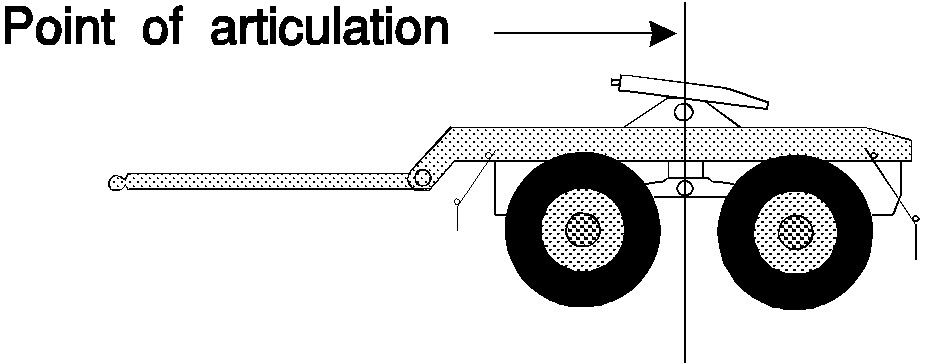
Point ofarticulation—fifth wheel coupling on a converter dolly (forming the frontaxle group of a dog trailer)
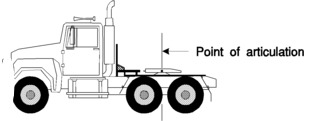
Point of
articulation—fifth wheel on a prime mover

Pointof articulation—axis of a kingpin for fifthwheel
(a) is attached to a towing vehicle by a pole, or an attachment fitted to a pole; and
(b) is ordinarily used for transporting loads, such as logs, pipes, structural members or other long objects, that can generally support themselves like beams between supports.

Pole-typetrailer
(a) if there is a single axle at the rear of the vehicle—the centre-line of the axle; or
(b) if there is an axle group at the rear of the vehicle—the centre-line of the axle group, decided without regard to the presence of any steerable axle unless all axles in the group are steerable.
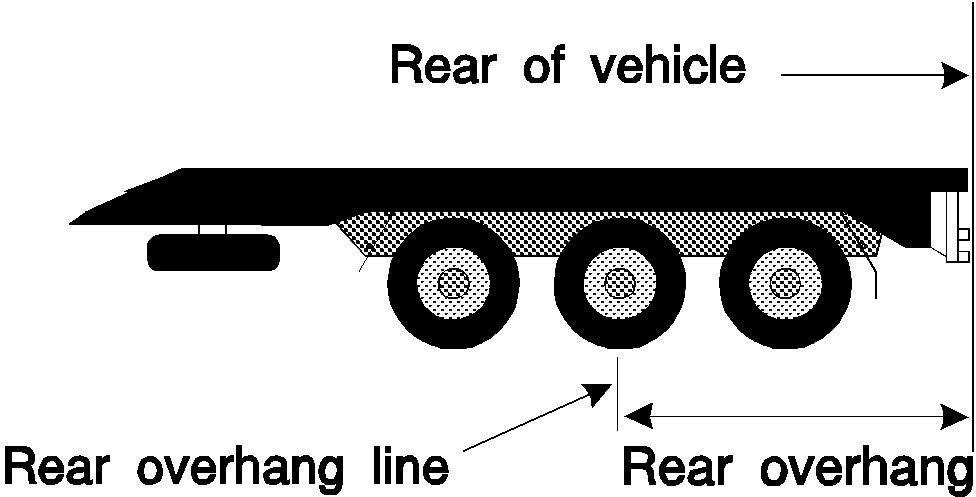
Rear overhang and rear overhang line—vehicle with tri axle group at rear
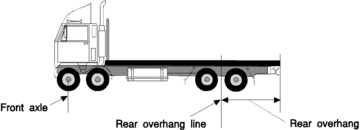
Rear overhang and rear overhang line—motor vehicle

Rear overhang and rear overhang line—semitrailer
(a) for a heavy vehicle—the vehicle's type under the Road Transport Charges (Australian Capital Territory) Act 1993 (Cwlth); or
(b) for a light vehicle—the vehicle's category under the current determination of the Minister under section 96 of the Road Transport (General) Act 1999 determining the fees, charges and other amounts payable in relation to the registration of vehicles.
(a) for a registered vehicle or a vehicle that has been, but is no longer, registered in any jurisdiction—the vehicle registration authority that last registered the vehicle; or
(b) if the vehicle has never been registered—the vehicle registration authority for the jurisdiction where the vehicle is used or intended to be used.
(a) to a non-standard registration number—see regulation 46 (Definitions for pt 3.5 (Numberplates)); and
(b) for a vehicle—means to the right of the centre of the vehicle when viewed by a person in the vehicle who is facing to the front of the vehicle.
Note The code is available at Ausinfo bookshops.
![]()
Road train
(a) 1 axle group or single axle to the rear; and
(b) a means of attachment to a prime mover that results in some of the load being imposed on the prime mover.
(a) in which the part of the body form adjacent to and in front of the front seat or seats, and most of the mechanical equipment, are the same or substantially the same as in a car of the same make; and
(b) in which the body is carried without significant reduction in height from the front seat or seats to, or substantially towards, the rear of the vehicle; and
(c) that has an entrance at the rear suitable for loading and unloading goods; and
(d) that is built with a rear seat or seats that can be folded or removed readily to provide additional floor space for goods; and
(e) that, when the seat or seats immediately to the rear of the front seat or seats are in position to seat people, the vehicle has a substantial space for goods in proportion to the overall size of the interior of the vehicle.
(a) for a motorbike or motortrike—the mass of the vehicle when ready for use, unoccupied and unladen, with all fluid reservoirs filled to nominal capacity (except the fuel tank which must be empty) and with all standard equipment and any options fitted; and
(b) for any other vehicle—the mass of the vehicle when ready for use, unoccupied and unladen, with all fluid reservoirs filled to nominal capacity (except for the fuel tank which must contain 10L of fuel) and with all standard equipment and any options fitted.
(a) see the Road Transport (General) Act 1999, section 100; and
(b) includes a restricted taxi.
(a) is built or used for towing broken-down or damaged vehicles; and
(b) includes, or has permanently attached to it, a crane or similar apparatus for—
(i) lifting a vehicle partly clear of the ground; and
(ii) keeping it partly clear of the ground while towing it.
(a) is built mainly to supply motive power for machinery or to haul another vehicle; and
(b) cannot carry a load (other than tools, spare parts, fuel, water, oil, or other accessories, necessary for use in connection with the vehicle) or any part of the weight of a vehicle being towed or its load.
(a) to carry goods or merchandise or to carry materials used in a trade, business or industry; or
(b) for use in work other than carrying people;
but does not include a motorbike or tractor.
(a) a prime mover and a semitrailer; or
(b) the steering axle or axle group of a dog trailer and the body of the trailer; or
(c) a fifth wheel coupling and the vehicle to which it is mounted.
(a) with single tyres; and
(b) fitted to a motor vehicle; and
(c) connected to the same steering mechanism; and
(d) the horizontal distance between the centre-lines of which is at least 1m, but not over 2m.
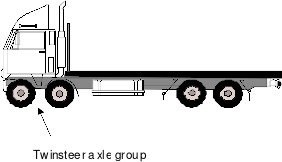
Twinsteer axle group on a motor vehicle
Endnotes
Notification
1 Notified in the Gazette on 29 February 2000.
Penalty units
2 Section 33AA of the Interpretation Act 1967 (as applied by section 9 of the Subordinate Laws Act 1989) deals with the meaning of offence penalties that are expressed in penalty units.
© Australian Capital Territory 2003